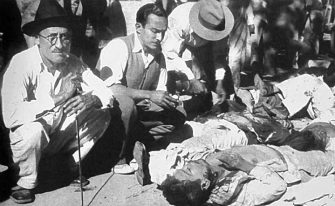This Day in Labor History: January 22, 1932

On January 22, 1932, the El Salvadoran military began what became known as La Matanza, or the Salvadoran Peasant Massacre, after Pipils in western El Salvador rose up against their oppression. Over the next five months, the military would murder upwards of 40,000 people in the western part of the nation, as well as some communists in the cities. This brutal suppression of a labor and political revolt was extreme, but also far too indicative of the ways in which Central American governments handled workers, often at the behest of North American interests.
The 1920s saw growing unrest in El Salvador as income inequality grew starkly. The elites had all the latest technologies from the United States while the vast majority of people lived horrible lives. Stated a U.S. military officer advising the government in 1931, “There appears to be nothing between these high-priced cars, and the oxcart with its barefoot attendant. There is practically no middle class.” These elites dominated the nation for the production of coffee. El Salvador was one of the world’s biggest producers of the crop and a mere 14 families controlled 90 percent of the nation’s land. As the big landowners took control over the land in the early twentieth century for coffee production, it’s not as if there weren’t already people on this land. Of course there was a long tradition of people living there, many of whom were indigenous. They now found themselves landless and forced into near-slavery conditions on the coffee plantations. Food consisted of a couple of tortillas and a scoop of beans at the beginning and end of each day. Other “compensation” was company scrip at high prices. Coffee planters reduced the food costs for workers to 1 cent a day. This was both profitable and horrifying.
The Great Depression hit and made the lives of coffee workers even worse. So in western El Salvador, largely populated by Pipils, they started organizing. This was done heavily through the Catholic Church, which was the only institution not totally controlled by the landowning class. Pipil leaders, known as caciques in Latin American politics, had been the way that the elites had controlled the average indigenous people, often through favors that would get the people to vote for whichever candidate had bought the cacique. But when they lost the caciques, who led the organizing, the landowning class was in trouble. The Pipil began creating economic cooperatives where they would get paid a bit for participating in Catholic festivals.
The Salvadoran government, led by the vile president Maximiliano Hernández Martínez, responded to the beginning of organizing with brutality. It created new laws such as theft of small items–food for instance–would be punished with the amputation of a hand. This did not help. Now, in the cities, the Communist Party was also on the rise. Active opposition to the regime was punished by death, so being a communist was a brave act. It’s leader was Agustín Farabundo Martí. The CP ran candidates in 1932 elections. The ruling party just committed outright fraud. So this increased the anger toward it among the people. Martí began to plan an uprising.
Now, it’s not clear whether Martí had any real connections with the indigenous leaders in western El Salvador. In any case, the uprising there was not started or led by the CP, though there was growing coordination as 1932 began. But both started fighting on the same day–January 22–and the government treated the uprising as one. Very quickly, the peasants took a bunch of towns. Equally quickly, the government took them back. Really, the peasants had no chance here. Of course, the U.S., Canada, and Britain all helped by sending ships and armaments for the government to use. After all, cheap coffee prices were a far higher priority than peasants. In truth, the Salvadoran government and military were proud that they did not need the help and turned it down. But the U.S. was ready to kill some peasants.
But hey, the Salvadoran government handled that on its own. Probably 25,000 most indigenous people were killed in the first 72 hours of the rebellion. That included most of the peasant leaders. One, Feliciano Ama, was hanged in front of hundreds of schoolchildren forced to watch to teach them what resisting the government would do. Martí was executed too. People were forced to dig their own mass graves and then were shot into them. People tried to flee to Guatemala, but its president closed the borders and deported everyone it could find back to the Salvadoran government for execution.
The aftermath of the rebellion was genocide. The Salvadoran government decided that the act of being Pipil was tantamount to treason. Most of the people were executed. For those who survived, their language and customs were suppressed. Denying your heritage became a key strategy for not being executed. Today, the language is mostly lost. Scholars have attempted to claim that the massacre did not lead to the erasure of indigenous identity in the country as assumed by both contemporary commenters and scholars, but there remains the fact that El Salvador is probably the farthest behind of any Central American nation in recognizing its indigenous heritage.
Martínez was finally thrown out of office in 1944.
Coffee remained cheap for western consumers. El Salvador remained a violent state that killed dissenters with American support, particularly during the 1980s.
This is the 422nd post in this series. Previous posts are archived here.


